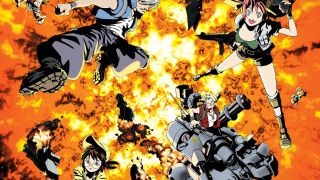The ultimate mega shock: the story of the legendary Neo Geo
Premium gaming at a premium price
Those who were flush enough to be able to afford to join this most exclusive of clubs were graced with some of the defining titles of the '90s. When Street Fighter II became a worldwide phenomenon in 1991 it spawned a legion of imitators, and SNK was at the front of the pack when it came to exploiting this new-found public adoration of one-on-one brawlers.
Takashi Nishiyama – co-director of the original Street Fighter in 1987 – jumped ship to SNK prior to the development of the sequel, and would oversee the production of series such as Fatal Fury, Art of Fighting and The King of Fighters, the latter of which would briefly become more popular in its native Japan than any of Capcom's offerings.
These games – as well as titles such as World Heroes, The Last Blade and Savage Reign – were considered to be at the forefront of the genre, and the Neo Geo quickly became the go-to system for fighting game addicts.

While it certainly found favour with players of a pugilistic persuasion, the system was also home to many other game styles. Perhaps the most famous is Metal Slug, which took the run-and-gun approach popularised by the likes of Contra and Gunstar Heroes and added layers of intricate graphical detail, as well as a healthy dose of humor.
Sports fans, meanwhile, were catered for by the excellent Neo Turf Masters, Soccer Brawl, Super Sidekicks and 2020 Baseball, while 'flying disc game' Windjammers – recently updated for the PlayStation 4 – became something of a cult classic. Shooter addicts had titles like Blazing Star, Viewpoint and Pulstar to keep them occupied, and puzzle lovers could entertain themselves with Puzzle Bobble and Panic Bomber, two third-party hits which used the Neo Geo hardware to superb effect.
The budget model
Despite its amazing stable of titles, it was obvious to everyone at the time that mainstream success would elude the Neo Geo while it remained such an outlandishly expensive proposition, so in 1994 SNK released the Neo Geo CD, which had the same internal technology but used compact discs in order to dramatically bring down the cost of software.
The idea was sound but the timing was all wrong; in the same year Sony and Sega released their much more powerful 32-bit consoles – the PlayStation and the Saturn – which put SNK's console well and truly in the shade.
Get daily insight, inspiration and deals in your inbox
Get the hottest deals available in your inbox plus news, reviews, opinion, analysis and more from the TechRadar team.

Despite this, the Neo Geo outlived both of those systems; Samurai Shodown V Special was the final official release, while indie developer NG:DEV.TEAM was producing software as late as 2012.
While it never sold in large numbers – unofficial estimates suggest that the entire Neo Geo console range shifted less than a million units worldwide – the fanbase which grew up around the console kept it alive for much longer than expected.
Despite a fumbled attempt to resurrect the brand with 2012's Neo Geo X handheld – in reality an emulation-based system with a lackluster LCD screen – SNK's thoroughbred console remains something of a cult classic.
Casual players can now experience most of its truly essential games via download services such as Nintendo's Virtual Console or Sony's PlayStation Network, leaving the task of collecting the original hardware and cartridges to only the most dedicated of fans – and this in itself is one of the most expensive undertakings in the world of interactive entertainment, with some super-rare AES releases – such as the European version of Kizuna Encounter: Super Tag Battle – costing as much as £10,000/$12,000.

Ironically, it's actually cheaper to collect the arcade-based MVS standard these days; while MVS carts were more expensive than their AES equivalents back in the day, large production runs mean these are now more abundant on the secondary market and are therefore significantly cheaper. As a result, many collectors choose to invest in 'consolized' MVS systems – basically arcade hardware that's been removed from a cabinet and converted for home use.
An enduring legacy
While the Neo Geo doesn't have a massive library, grabbing a complete collection is still the kind of venture that, for most people, will require re-mortgaging the house or selling a kidney – but therein lies the intrinsic appeal of SNK's legendary home system. Even at the time of its release it was alluringly unobtainable, a console which many had heard tell of but had never actually seen in the flesh.
The relentless march of technology means many of the systems we were so overawed by in the '90s now look pathetically weedy by modern standards, yet the Neo Geo – with its silky-smooth animation, CD-quality audio and screen-filling, hand-drawn sprites – has managed to retain its ability to dazzle – and that timeless quality is likely to endure as the decades roll by and the cost of ownership continues to rise.
Most Popular

